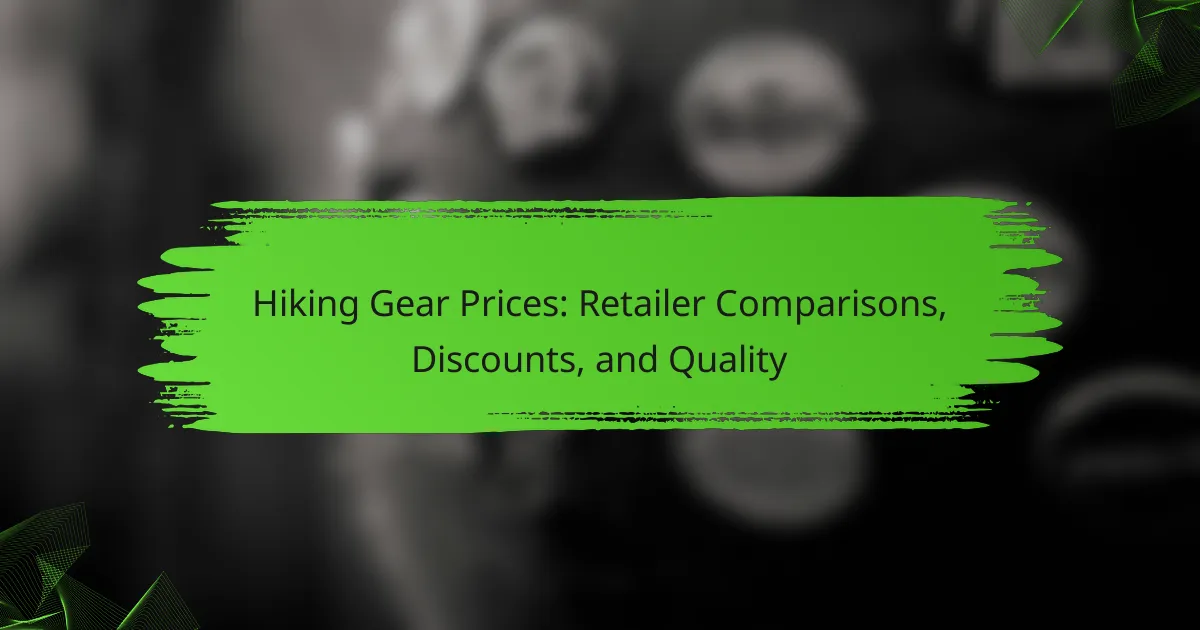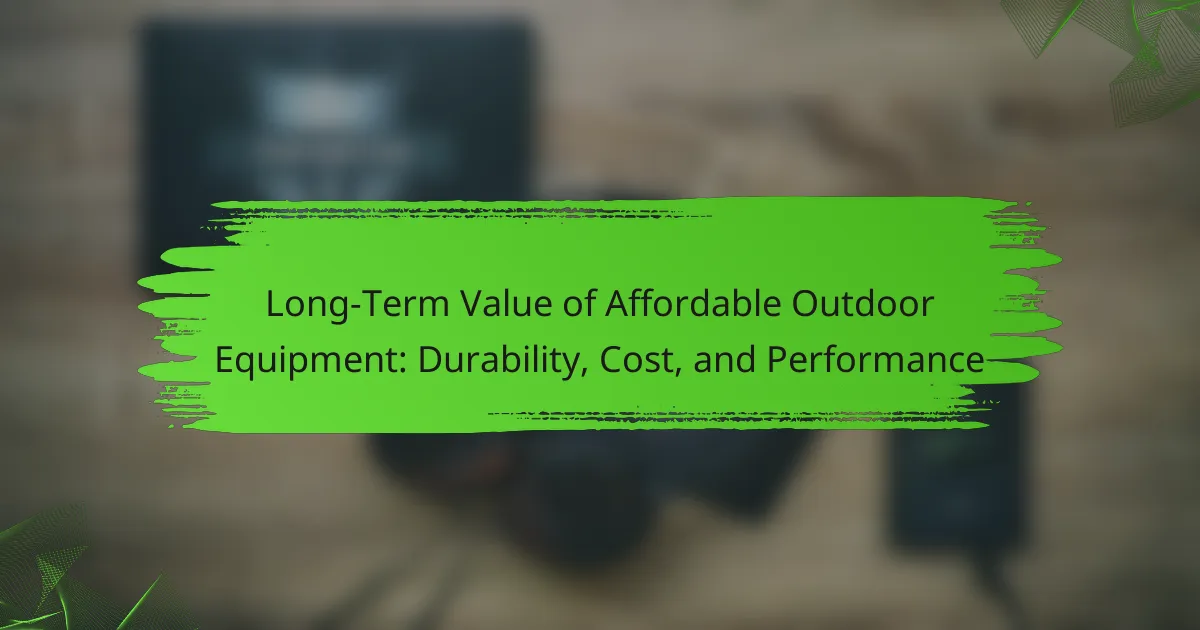When shopping for hiking gear, it’s essential to compare prices across various retailers, including both specialty outdoor stores and online platforms. By understanding the factors that influence pricing, such as brand and quality, you can make informed decisions and take advantage of seasonal sales and discounts to maximize your savings.

Where to find the best hiking gear prices in the US?
To find the best hiking gear prices in the US, consider comparing prices across various retailers, including specialty outdoor stores and online platforms. Look for seasonal sales and discounts to maximize savings while ensuring quality gear.
REI pricing comparisons
REI is known for its competitive pricing on outdoor gear, often offering member discounts and seasonal sales. Prices can vary significantly based on brand and product type, so it’s beneficial to compare similar items across different categories.
For example, a high-quality backpack may range from $100 to $300, depending on features and brand reputation. Members can take advantage of annual sales, which can offer discounts of 20% or more on select items.
Amazon discounts on hiking gear
Amazon frequently provides discounts on hiking gear, with prices fluctuating based on demand and availability. It’s common to find deals on popular brands, especially during major sales events like Prime Day or Black Friday.
Keep an eye on customer reviews and ratings to ensure quality, as prices can sometimes reflect lower-quality items. Utilizing price tracking tools can help identify when items drop to their lowest prices.
Backcountry price analysis
Backcountry specializes in outdoor gear and often features competitive pricing on high-end brands. Their pricing strategy includes regular sales and clearance events, making it a good option for budget-conscious shoppers.
For instance, discounts can range from 15% to 50% off during clearance sales. Additionally, Backcountry offers a price match guarantee, ensuring you get the best deal available on the market.

How do hiking gear prices compare across retailers?
Hiking gear prices can vary significantly between retailers, influenced by factors such as brand, quality, and seasonal sales. Understanding these differences helps consumers make informed purchasing decisions and find the best deals for their hiking needs.
Price differences between REI and Cabela’s
REI typically offers a range of high-quality outdoor gear, often at a premium price point, while Cabela’s may provide more budget-friendly options. For example, a mid-range tent at REI might cost around $300, whereas a similar model at Cabela’s could be priced closer to $200.
Both retailers frequently have sales, especially during seasonal transitions, which can lead to significant discounts. It’s advisable to compare prices during these sales events to maximize savings.
Comparing prices at Dick’s Sporting Goods
Dick’s Sporting Goods often features competitive pricing on hiking gear, especially for popular brands. Their prices can range from low to mid-hundreds for items like backpacks and sleeping bags, making them a solid option for budget-conscious shoppers.
Additionally, Dick’s frequently runs promotions and offers loyalty programs that can further reduce costs. Checking their website or signing up for newsletters can help keep you informed about the latest deals.
Walmart hiking gear pricing
Walmart generally provides some of the lowest prices for hiking gear, appealing to casual hikers or those just starting. Basic gear, such as hydration packs or camping supplies, can often be found for under $50.
While Walmart’s selection may not include high-end brands, they do offer decent quality for the price. It’s essential to read reviews and check product specifications to ensure the gear meets your needs before purchasing.

What discounts are available for hiking gear?
Discounts for hiking gear can significantly reduce costs, making outdoor equipment more accessible. Retailers often provide seasonal sales, student discounts, and membership benefits that can help you save money on your purchases.
Seasonal sales at outdoor retailers
Many outdoor retailers offer seasonal sales, particularly during major holidays or at the end of hiking seasons. Discounts can range from 20% to 50% off, depending on the retailer and the timing of the sale.
For example, Black Friday and end-of-summer clearance events are prime times to find deals on hiking boots, backpacks, and apparel. Keep an eye on retailer websites and sign up for newsletters to stay informed about upcoming sales.
Student discounts on hiking equipment
Students can often access exclusive discounts on hiking gear, typically ranging from 10% to 20% off. Many outdoor brands partner with student discount programs to offer these savings.
To take advantage of these offers, students should verify their status through platforms like UNiDAYS or Student Beans. Always check the retailer’s website for specific terms and conditions regarding student discounts.
Membership benefits for hiking gear savings
Joining membership programs at outdoor retailers can unlock additional savings on hiking gear. Membership benefits may include exclusive discounts, early access to sales, and rewards points on purchases.
For instance, some retailers offer loyalty programs where members can earn points for every dollar spent, which can later be redeemed for discounts. Consider signing up for these programs if you frequently purchase hiking equipment to maximize your savings.

How to evaluate the quality of hiking gear?
To evaluate the quality of hiking gear, consider factors such as material durability, customer reviews, and brand reputation. These elements help ensure that the gear will withstand the rigors of outdoor activities and meet your specific needs.
Material durability of popular brands
Material durability is crucial for hiking gear, as it determines how well the equipment can withstand wear and tear. Look for items made from high-quality fabrics like nylon or polyester, which are often more resistant to abrasions and weather conditions.
Brands such as The North Face, Patagonia, and Columbia are known for their durable materials. Checking the denier rating of fabrics can also provide insights; higher denier numbers generally indicate stronger materials.
Customer reviews on hiking gear quality
Customer reviews are a valuable resource for assessing the quality of hiking gear. Look for feedback on performance, comfort, and longevity to gauge how well a product holds up in real-world conditions.
Websites like REI and Amazon allow users to leave detailed reviews, often highlighting specific pros and cons. Pay attention to reviews that mention long-term use, as these can provide insights into durability and reliability.
Brand reputation in outdoor gear
Brand reputation plays a significant role in the perceived quality of hiking gear. Established brands often have a track record of producing reliable products, which can provide peace of mind when making a purchase.
Researching brand history and customer service can also be beneficial. Brands like Merrell and Osprey are frequently praised for their commitment to quality and customer satisfaction, making them safer choices for outdoor enthusiasts.

What are the key factors affecting hiking gear prices?
Hiking gear prices are influenced by several key factors, including brand reputation, material quality, and current market demand. Understanding these elements can help consumers make informed purchasing decisions and find the best value for their needs.
Brand influence on pricing
The brand of hiking gear significantly impacts its price, as well-known brands often command higher prices due to their established reputation for quality and reliability. Consumers may pay a premium for brands recognized for durability and performance, while lesser-known brands may offer similar products at lower prices.
When comparing brands, consider the warranty and customer service offered. A brand with a strong support system may justify a higher price, as it can provide peace of mind and long-term value.
Impact of material and technology on cost
The materials used in hiking gear, such as waterproof fabrics and lightweight composites, directly affect production costs and, consequently, retail prices. High-performance materials often come at a premium, but they can enhance comfort and durability during hikes.
Additionally, advancements in technology, such as moisture-wicking capabilities or integrated GPS, can increase costs. While these features can improve the hiking experience, it’s essential to assess whether they align with your specific needs and budget.
Market demand fluctuations
Market demand for hiking gear can vary seasonally and based on trends, impacting prices. During peak hiking seasons, prices may rise due to increased demand, while off-season sales can offer significant discounts.
To get the best deals, consider shopping during off-peak times or looking for sales events. Keeping an eye on retailer promotions can help you find quality gear at a more affordable price.

How to choose hiking gear based on budget?
Choosing hiking gear based on budget involves balancing quality and cost to ensure safety and comfort on the trail. Start by determining your spending limit and prioritize essential items, as well as considering the longevity and performance of the gear.
Budget-friendly hiking gear options
Budget-friendly hiking gear typically ranges from around $50 to $150 for essential items like backpacks, sleeping bags, and basic footwear. Look for sales at outdoor retailers or consider second-hand options to stretch your budget further.
Brands that offer reliable yet affordable gear include REI Co-op, Columbia, and Merrell. Focus on features that provide the best value, such as waterproof materials and good insulation, without overspending on brand names.
Mid-range gear recommendations
Mid-range hiking gear usually costs between $150 and $400 and offers better durability and performance. This category includes higher-quality backpacks, tents, and footwear that can withstand more rigorous conditions.
Consider brands like The North Face, Patagonia, and Osprey for mid-range options. Look for features such as ergonomic designs, enhanced breathability, and advanced materials that improve your hiking experience while still being budget-conscious.
High-end hiking equipment features
High-end hiking gear often exceeds $400 and includes specialized equipment designed for serious hikers and adventurers. This gear typically features advanced technologies, such as lightweight materials, superior insulation, and enhanced waterproofing.
Brands like Arc’teryx, Black Diamond, and Salomon offer premium products that cater to extreme conditions. Investing in high-end gear can significantly improve performance and comfort, but ensure it aligns with your hiking frequency and environment to justify the expense.



